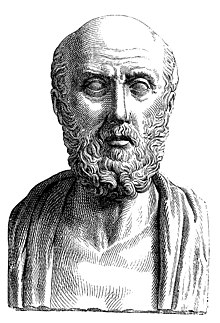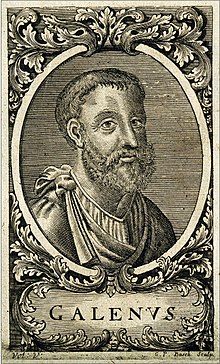Disease and Infection - Key People
- Created by: sammyjja
- Created on: 07-02-17 19:27
Aristotle
Name: Aristotle
Time Period: Ancient Greece
Lifetime: 384 - 322 BC
What did he do?: He wrote down and published the 'Theory of 4 Humours' theory that was created by Galen.
Legacy: His (and Hippocrates') ideas were believed until the Renaissance (with Galen's added ideas of the 'Theory of Opposites'
Hippocrates

Name: Hippocrates
Time Period: Ancient Greece
Lifetime: 460 - 370 BC
What did he do?: Hippocrates came up with the 'Theory of 4 Humours' (which was written down by Aristotle) He also created the 'Hippocratic Oath' which means that Doctors had to obey behaviour rules within their professional work
Legacy: The 'Theory of 4 Humours' was later developed upon by Galen (the 'Theory of Opposites') and this lasted until the Renaissance when, eventually, the ideas were challenged
Galen

Name: Galen
Time Period: Ancient Rome
Lifetime: 130 - 210 AD
What did he do?: Galen created the 'Theory of Opposites' which stated that, to treat the 4 Humours, you must use the opposite humour to treat it - e.g. if you are too hot, you treat it with cold Galen also believed in Observation - observing and recording patient's symptoms over time to determine what was wrong and to be used in the future
Legacy: Galen's legacy lasted for many, many years with his books destroyed (Dark Ages) and brough back (Middle Ages) before being, finally, contradicted and disproved in the Renaissance
Avicenna
Name: Avicenna (Ibn Sina)
Time Period: Islamic Empire
Lifetime: 980 - 1037
What did he do?: Avicenna challenged the ideas of Galen within the Islamic period and published medical books, the most famous of these being the 'Canon of Medicine'
Legacy: His ideas eventually spread to Europe (including the 'Canon of Medicine' during the Crusades war and his ideas began to spread through Europe after this
Rhazes
Name: Rhazes
Time Period: Islamic Empire
Lifetime: 865 - 925
What did he do?: Rhazes took the books of Galen and Hippocrates and translated them into Arabic and then used and conserved the ideas to use within the Islamic Empire
Legacy: His copies of Galen and Hippocrates' ideas were taken back to Europe in the Middle Ages after the Crusade wars and were used and followed until the Renaissance
Paracelsus
Name: Paracelsus
Time Period:
Lifetime: 1493 - 1541
What did he do?: Paracelsus gave lectures, in German rather than Latin, and his lectures defied the lessons of Galen and the 'Theory of 4 Humours' and called Galen a liar
Legacy: He began a chain reaction of people finally questioning Galen so other (correct) theories could overtake it
Jenner
Name: Edward Jenner
Time Period: Industrial Revolution
Lifetime: 1749 - 1823
What did he do?: Jenner discovered Vaccines after he realised that milk maids, who had cowpox, would not contract small pox. To test this, he injected a boy, called James Phipps, with cowpox and then, after he recovered from it, weak smallpox. Phipps did not contract smallpox and, thus, vaccines were discovered
Legacy: The idea of vaccines would last for years after (after being developed upon by many others) and vaccines are still used in the Modern World
Pasteur
Name: Louis Pasteur
Time Period: Industrial Revolution
Lifetime: 1822 - 1895
What did he do?: Louis Pasteur discoved that germs cause disease and published his findings in his Germ Theory. He had tested air using swan-necked flasks and discovered that a swan-necked flask stopped germs as germs were in the air.
Legacy: His Germ Theory overtook the idea of Spontaneous Generation and has lasted since its discovery right into the Modern World and is considered to be the correct theory.
Koch
Name: Robert Koch
Time Period: Industrial Revolution
Lifetime: 1843 - 1910
What did he do?: Koch was able to, using a microscope, identify and stain different types of bateria and link them to the disease that each one caused
Legacy: His ideas and identification of those bacteria lasted way into the Modern World
Ehrlich
Name: Paul Ehrlich
Time Period: 20th Century
Lifetime: 1854 - 1915
What did he do?: Ehrlich was the first person to search after the 'magic bullet' that would cure disease and, by 1914, had discovered many 'magic bullets; with his team
Legacy: His 'magic bullets' have lasted into the Modern World and are used in the creation of antibiotics
Fleming
Name: Alexander Fleming
Time Period: 20th Century
Lifetime: 1881 - 1955
What did he do?: Alexander Fleming accidentally discovered Pencillin when he noticed that some bacteria in a Petri dish has been killed by natural Penicillium mould and this led to the discovery of Penecillin asan antibiotic
Legacy: His discovery was picked up and continued by Florey and Chain and Penecillin is a well used drug in the Modern World
Florey and Chain
Name: Florey and Chain
Time Period: 20th Century
Lifetime: Florey - 1898 - 1968
Chain - 1906 - 1979
What did they do?: They came across the findings of Alexander Fleming and set about the mass production of Penecillin as an antibiotic. They struggled at first, using milk bottles with mould in to produce it but, eventually, were able to mass produce it in America and it was used a lot during the war to help people
Legacy: They (along with Fleming) received Noble Prizes for Penecillin and it is still a popular antibiotic in the Modern World
Watson and Crick
Name: Watson and Crick
Time Period: 20th Century
Lifetime: Watson - 1928 - present
Crick - 1916 - 2004
What did they do?: In 1953, they published their discovery on the structure of DNA. Using 3D X-Ray technology, they discovered that DNA had a double-helix structure and exactly how it was structured like this
Legacy: Their discovery on the structure of DNA is still very important to this day in the Modern World and is regulary used within work on genes
Related discussions on The Student Room
- GCSE History Study Group 2022-2023 »
- AQA GCSE History Paper 2 (8145/2) - 7th June 2023 [Exam Chat] »
- Disease X: A hidden but inevitable creeping danger »
- EPQ suggestions - Pharmacy related »
- Clearing gave me a second chance »
- Why do I have whopping cough only when I go to sleep »
- What gcse options should I pick if wanna be a future pharmacist??? »
- OCR A-Level Geography Geographical Debates | [12th June 2023] Exam Chat »
- What is actually studied in a pharmacy degree? »
- Edexcel GCSE History Paper 1 (1HI0 10-13) - 18th May 2023 [Exam Chat] »
Comments
No comments have yet been made